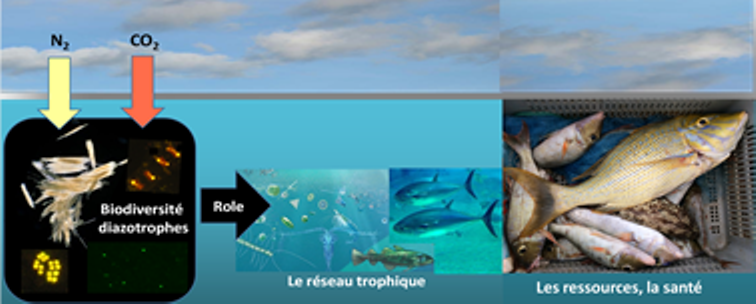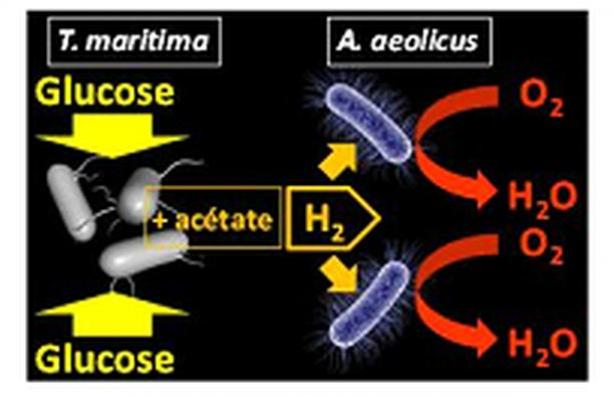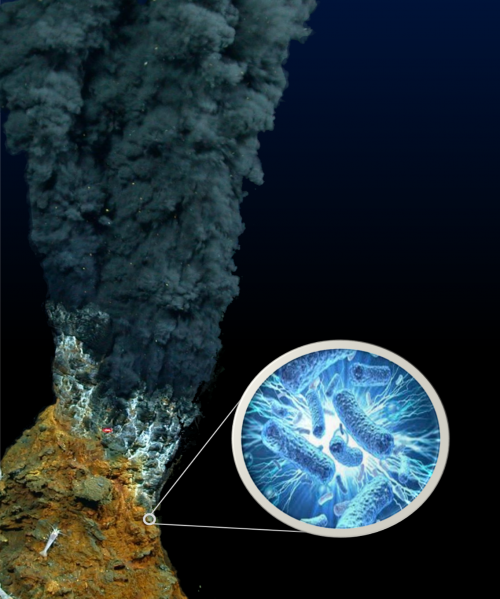MEB - Topic 1
Dynamics in complex microbial systems: relationships and interactions between organisms
Moderator : Cécile Militon
Interactions among community members (including symbionts) could produce endogenous dynamics in composition and activities, even in the absence of environmental changes. Our aim is to consider these endogenous dynamics in combination with environmental factors to reach a more integrated understanding of the functioning of complex microbial systems. In our programs, we will focus on direct and indirect microbial interactions (prokaryotes, viruses and unicellular eukaryotes) and those between macro- and microorganisms (macrobenthos, macrophytes, and metazoan plankton).
Our main scientific issues concern (i) the transfer of metabolic products (metabolic coupling), (ii) the sharing of metabolic pathways and (iii) the horizontal gene transfer (HGT) throughout the ecological network of microbial communities. The role of the physical and chemical signals in the establishment of these interactions (e.g., bioluminescence) is also studied. Data from environmental genomics are integrated by developing several bioinformatics tools, such as the OGA website (Ocean Gene Atlas).
Examples of studies
Interspecific hydrogen transfer: microorganisms in hydrogen biogeochemical cycles at marine hydrothermal vents
Molecular hydrogen (H2), which could be an intermediate metabolite that is produced by some microorganisms and consumed by others, plays an important role in the regulation and functioning of microbial trophic networks within terrestrial or marine anaerobic ecosystems. Research studies focus on the mechanisms of interspecies H2 transfer between H2-producing anaerobic and H2-consuming microaerobic hyperthermophilic microorganisms.
Biotechnical projects that are linked to bioenergy production are also developed by using the capability of hyperthermophilic bacteria to produce H2 from various sugars (topic 5).
Electronic mutualisms: electroactive microorganisms from deep-sea hydrothermal vent systems
Some microorganisms can exchange electrons with an insoluble electrical conductor. The team is studying the electroactivity of thermophilic and hyperthermophilic microorganisms that are linked to extreme and/or hydrothermal-vent ecosystems. In particular, we focus on electroactive microbial communities (electrotrophic or electrogenic) and electronic mutualism (Direct Interspecies Electron Transfer (DIET).
This research is also related to the production of electrofuel and electric power (see topic 5).
Importance of diazotrophic cyanobacteria in food webs
Within some subtropical marine ecosystems in the Southwest Pacific, a paradoxical bloom of phytoplanktonic microorganisms is observed in oligotrophic water zones (SPOT - South Pacific Ocean Time Series - program). We identify these microorganisms to understand the effect of their metabolism on the trophic network, the last levels being exploited by human beings.
Thus, we study their biodiversity, metabolism (see topic 5) and interactions with viruses and micro and macro components of plankton and nekton. This research project is developed in partnership with the Kanak civil society.

Bioluminescence
Our goal is to understand the role of bioluminescence in marine geochemical processes by using photobacterium phosphoreum ANT-2200 (bioluminescent bacterium that is isolated at the ANTARES site (Astronomy with a Neutrino Telescope and Abyss environmental RESearch project) at 2200m depth).
This research is based on multi-domain skills that are developed in the laboratory (physiology at atmospheric and high pressures, genetics, transcriptomics, etc.) and has an applied aim through collaboration with the company “TANGRAM Architectes” for the implementation of bioluminescence in a sustainable Mediterranean habitat model (collaboration labeled CapEnergie Pole, Pole Sea, recognized by the PACA Region and awarded by the Rougerie Foundation).




